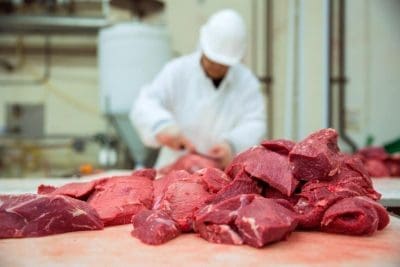MEAT protein giant JBS’s investment in salmon production in Australia will provide a platform for new growth beyond the company’s existing red and white meat businesses, analysts were told during the company’s recent second quarter earnings results conference call.

JBS told analysts its ambition was to become a globally-significant player in the salmon aquaculture industry, just as it now was in beef, pork and chicken.
The company also expanded on brief comments made during its second quarter results announcement last week, comparing the performance of the company’s Australian beef and lamb processing operations with those in North America. Both operate within the JBS US beef division, but financial results are reported conjointly.
As Beef Central reported earlier this month, subject to shareholder approval, JBS plans to buy Australia’s second largest aquaculture business, Huon Aquaculture in Tasmania, for $546 million.
Morgan Stanley analyst Ricardo Alves, asked two fundamental questions of the world’s biggest animal protein producer: Why aquaculture, and why Australia?
JBS global chief executive Gilberto Tomazoni said JBS’s strategy in entering a new protein category was driven by an ambition to develop a new platform for growth within the overall business.

Gilberto Tomazoni
“We want to build a strong position in each category, as we have in beef, chicken and pork,” Mr Tomazoni said.
“We started (moving from beef, the company’s original focus) into chicken in 2009, and we are now number one. We also started pork, and we are now the number two producer – and we will do the same in aquaculture,” he said.
Mr Tomazoni said JBS’s interest in seafood was not in wild-caught fishery, but specifically in aquaculture.
“We do not see opportunity to catch fish growing, but aquaculture will grow, and this is an opportunity because the category (demand) keeps growing.”
“From the consumer’s perspective, it’s high nutrition and has health benefits. Production efficiency in aquaculture is advancing in terms of costs, and feed costs. And aquaculture is more sustainable (than wild-caught fishery).”
“And why Australia? Because Australia was the opportunity. We looked for opportunities in this category in all other areas, but Australia was chosen. JBS has a global presence – we can embrace opportunities globally. And this opportunity in Australia was a really great one, because the country has high standards, great technology and an animal welfare environment.
“We have a team there, we have management, we know the consumer, we know the costumers, we know the market – it is perfect fit to our strategy to grow in another category in a place that we already have a strong presence,” Mr Tomazoni said.
JBS already has extensive red meat cold storage, distribution, sales and marketing channels in place across global food markets, which could easily accommodate salmon products if required, analysts said earlier.
Australian processing still ‘way, way behind’
Analysts also focussed on the dramatic contrasts between processing margins in the company’s US beef operations, and those in Australia at present.
Barclays analyst Ben Theurer asked about the performance in the US beef business versus Canada and Australia/New Zealand from the profitability perspective.
“Clearly, we saw only a minor improvement on the year-over-year result, and I’d like to understand how much Australia was still a drag on results,” Mr Theurer said. “How was the US business on a standalone basis, from an EBITDA contribution?

Andre Nogueira
JBS US beef division chief executive André Nogueira reminded the briefing that JBS did not publish its US Beef division results separately, but said Australia, combined with New Zealand (trading) beef the lamb and the prepared food business in the region represented around 20 to 25pc of the US Beef Division business, depending on currency. Canada represented 10-12pc, again dependent on the currency at that point.
“Canada, in terms of margin, is currently very similar to the US, both for fed beef (that is today the highest margin business) and cow business (non-fed manufacturing beef).
“Australia is currently way, way below that,” Mr Nogueira said, based on current extreme high cattle procurement costs and short supply, caused by drought.
“Although the second quarter (ended 30 June) was an improvement over the previous quarter for Australia, it was not an improvement over the same quarter last year.
“Australia is still well below what we consider the normal margin for the combined Australia business,” he said.
Improvement in by-product value
Mr Nogueira pointed out that one area of recent improvement was in the by-products area.
“Within the 20pc margin that we showed last quarter, the improvement in the by-products is responsible for 4pc of this 20pc, with improvement in all areas from edible offals to hides and other by-products. Rendering (meatmeal and tallow) is also much better, and in my mind it’s very sustainable, because of the new price level of oil and fat, because of renewable fuel. Beef Central reported on recent changes in global hides value in this earlier article.
“So in the beef area, we have seen improvement of more than $100 per head (not made clear whether this comment referred to US operations only, or also those in Australia) when we compare the second quarter, year-on-year. And that’s a very sustainable improvement in my mind.”
Analyst Ben Theurer asked whether Mr Noguiera’s comments meant that JBS’s US operations, in isolation from Australia, were somewhat similar in financial performance to what competitors were reporting in the US. “Has it been dragged down because of the Australian impact? He asked.
Mr Nogueira said having seen the earlier published numbers of US competitors, JBS US operations (in isolation) had outperformed all the other companies, “by a pretty good margin.”
“And that has been a trend that has happened in the last five years – we have year-over-year increased that gap over our US competitors. In the second quarter, that gap is one of the highest in history, and we continue to grow this gap between us and our US beef competitors,” he said.
